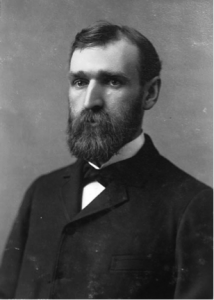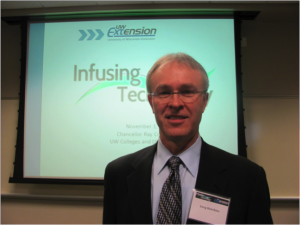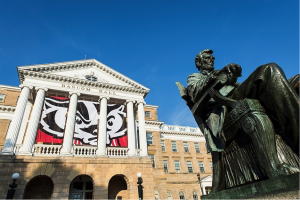by Curt Hogg
In 1904, UW-Madison president Charles Van Hise summarized the motivation behind the Wisconsin Idea when he declared he would “never be content until the beneficent influence of the university reaches every family in the state”. And, as the decades since have fallen in the rearview mirror, the Wisconsin Idea has remained at the forefront of the university’s education and research.

Now, fueled by a tuition increase and budget cuts, the university that has long embraced the Wisconsin Idea faces their latest challenge: maintaining their long-standing commitment to this philosophy that fosters their contributions to the state.
The Wisconsin Idea dates far back into the history of the UW System, particularly so with UW-Madison, its flagship school. Presently, while the university’s commitment to the Wisconsin Idea is equable and unwavering, its practical implementation may not be in the future.
In January 2015, Wisconsin Gov. Scott Walker, facing a deficit of up to $2 billion, proposed a $300 million cut in state funding to the UW System for the fiscal year of 2015-16 that would pass through the legislature this summer. UW-Madison would be inflicted with 11.6 percent of that $300 million. Chancellor Rebecca Blank wrote that the University’s plan to handle the cuts includes eliminating approximately 400 positions.
On April 6, Blank also announced that UW-Madison was seeking to raise tuition for nonresident, international, graduate and professional students by up to as much as 20 percent. Four days later, the UW System Board of Regents for UW-Madison approved the tuition increase, as well as seven other four-year public state universities.
Blank wrote that “we need to do this”, continually citing rising costs of operation, falling behind peers in the market-level tuition cost and the university “facing a difficult budget situation” as the reasons for the tuition hike.
For Blank, who has her doctorate in economics from Massachusetts Institute of Technology, reaching market levels has been an important objective. These tuition hikes, however, play into a growing concern of college affordability.
“One thing that’s been found by a number of outside researchers is that there’s an aspect of charging out of state students higher tuition that can make college less affordable for Wisconsin students, and even many of those from out of state,” Wisconsin HOPE Lab managing director Jed Robertson said.
The HOPE Lab, located on the UW-Madison campus, aims to improve equitable outcomes and affordability for college education. Among their qualifications for an “ideal” incoming class at UW-Madison include “no less than 60 percent of the entering class should be residents of Wisconsin” and that “the median family income of Wisconsin resident students on the Madison campus should reflect the median family income of the state”.
Blank hopes to raise $40.4 million in the first two years, and a total of $70 million over four years.
The raises came as no surprise to officers at the Associated Students of Madison, UW-Madison’s official student government, saying Blank has been advocating for raising tuition since she took office in July 2013.
“This was not out of the blue for us,” ASM University Affairs Committee chair John Paetsch said. “This has been coming, and with the budget cuts at the state level, this is the perfect time for this to happen for her, because she can rationalize it.”
Paetsch added that “shades of gray” surround the precise reasoning for the tuition raises. But, while that remains unclear, one thing in particular is evident: the university will soon be undergoing changes, and those changes may affect how the university applies the Wisconsin Idea.
For over a century, the Wisconsin Idea has shaped how university research is applied to solve problems and improve the lives of citizens across Wisconsin. Its extension to the rest of the state has been the driving factor.
“In no other state in the union has any university done the same work for the community that has been done in Wisconsin by the University of Wisconsin,” President Theodore Roosevelt said.
Following the words of Van Hise—after whom the tallest building on campus is named—the university’s commitment to reaching all the borders in the state is longstanding.
“This is the University for Wisconsin,” Paetsch said.
And no organization does more to put Van Hise’s words to action than the UW-Extension. Promoting itself as “the face of the Wisconsin Idea”, the system provides the entire state with access to university resources and benefits of research. In many ways, it also serves as the muscles of the Wisconsin Idea.
“We understand [the Wisconsin Idea] to be the university’s commitment to the state and the people of the state,” said Greg Hutchins, UW-Extension Associate Vice Chancellor.
UW Extension, the Wisconsin Idea’s face organization, would be on the end of over 10 percent of the $300 million cut to the UW System in the likely case that the budget passes. Though the cuts would surely bring about change to Extension, they assure that the Wisconsin Idea isn’t going anywhere.

“If we get smaller, it’s fewer people representing the Wisconsin Idea, but it’s not such a dramatic reduction that the Wisconsin Idea goes away,” Hutchins aid. “Extension will still be prevalent in people’s lives and communities, and Extension will still have an image and character across the state.”
Students at UW-Madison also find the Wisconsin Idea to be important. Out of 639 respondents, 88 percent answered that the Wisconsin Idea was either very important or somewhat important to the mission of the university.
UW-Madison’s longstanding commitment to the Wisconsin Idea will not go away in the face of the budget cuts. What will change, however, is how it is implemented into the state.
“Bottom line, ultimately, these kinds of reductions make the Extension smaller and it reduces the delivery of the Wisconsin Idea,” Hutchins said.
According to Paetsch, the ones on the end of the biggest blow from both the budget cuts and tuition increases are the UW-Madison students, which has larger ramifications for the state.
“The idea is that the people most hurt by the cuts at the end of the day are the students,” Paetsch said. “We want to show that while these cuts may be targeting at cutting bureaucratic flow, faculty and so on, we’re the ones being hurt by these cuts.”
The message ASM is advocating in regards to the cuts to the university and tuition raise is simple: “When you support the students, you support the state,” Paetsch said.
UW-Extension consists of four major divisions, all of which place an emphasis on expanding UW-Madison’s reach to the entire state. There is Continuing Education, which helps people complete degrees off-campus; Cooperative Extension, which has offices in every county to help understand those communities’ needs; Public Broadcasting, which disseminates education to state residents through television and radio; and Business and Entrepreneurship, which is focused on business creation, growth and performance.
If the budget cuts were to go through, Cooperative Extension would be presented with the toughest challenge, Hutchins said.
“They’re working to reconfigure their organizational structure long-term,” Hutchins said. “We don’t know exactly what it will look like yet, but they’re working on it.”
It’s hard to tell currently what exactly many components of the university, UW-Extension and even the Wisconsin Idea will look like.
The state budgets cuts will clearly affect the university, but to what degree they aren’t sure—for example, two state representatives are proposing a bill that would exempt UW-Extension from cuts.
“That’s the kind of unknown that’s out there,” Hutchins said of the proposed bill. “There are so many unknowns in the situation, as to where we’re going.”
Increases in tuition are expected to present a smaller representation of nonresident students on the UW-Madison campus in upcoming semesters, or it could be, Paetsch adds, that the demographic of that selection of students changes.
“One of the most notable effects is going to be pricing out,” Paetsch said. “You’re going to see a mass migration of the people who won’t be able to afford to come to UW-Madison from out of state. You’re going to have constrained diversity, economically.”
The ramifications of raising nonresident and professional tuition may also include an impact on in-state undergraduates.
“Students with more money want more amenities, and that’s who we’ll see at UW-Madison at a greater clip in the future,” Robertson said. “It could make parts of campus less accessible to students who don’t have those resources.”
As for the Wisconsin Idea, the university remains committed. Extension will remain as the “face of the Wisconsin Idea” amidst its cuts and the university’s research will continue to reach out to the state.

While the commitment is unwavering, there are changes to the implementation of the Wisconsin Idea. Those are much less from tuition raises, but, rather, from the cuts—specifically those to Extension. With 72 county offices, 269,000 face-to-face agricultural education contacts, 537,000 weekly Wisconsin Public Television viewers and 505 jobs created, change of some sorts is coming.
Hutchins is working on a committee titled “Reimagining UW-Extension” that asks “how it can remain strong and relevant for the next 100 years”. With forums taking place across the Badger State, the service stemming from the Wisconsin Idea will look very different in 2050 than in 2015.
Any large issue involving a change to the Wisconsin Idea stemming from tuition increases would have to come about with significant in-state tuition hikes. These would limit direct access to UW-Madison for certain demographics of current university students—and, with the current trend, in-state raises may not be too far in the future.
“They’re not two separate revenue streams,” Paetsch said. “You can think of in-state tuition as out-of-state tuition plus subsidy, and that state subsidy is drying out. The base is increasing as we’re seeing with this out-of-state increase.”
Paetsch added that he would bet his “future salary that we’re going to see increase in in-state tuition eventually”. Currently, an in-state tuition freeze remains for UW-Madison students through the 2016-17 school year. On her website, Blank wrote that she was hoping to keep in-state tuition at its current rate.
Through tuition increases and budget cuts, the university’s plans to continue its dedication to the Wisconsin Idea.
“We remain committed to the Wisconsin Idea,” Hutchins said. “We’re still a substantial-sized institution that’s going to deliver on the Wisconsin Idea.”
For more information on this topic, click here.
